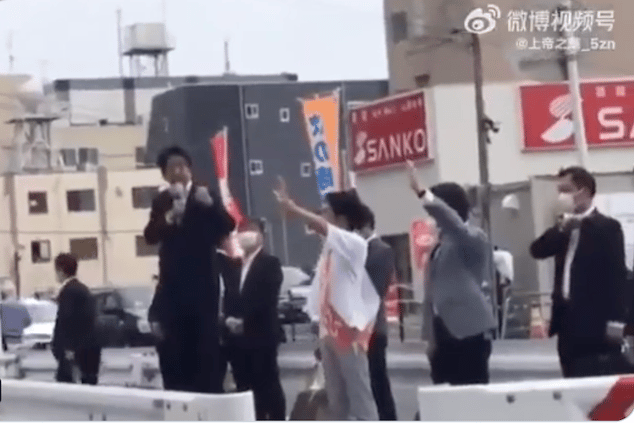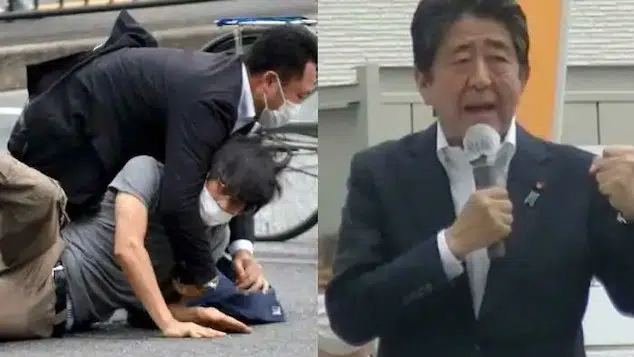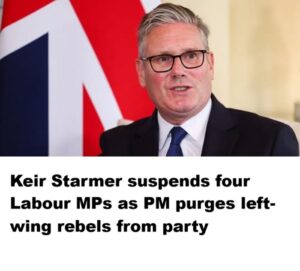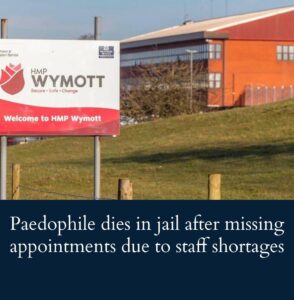Tetsuya Yamagami shoots & kills Shinzo Abe ex Japanese prime minister. No known motive as assassin says he aimed to kill but had no political gripe.
A Navy veteran is suspected of shooting and killing Shinzo Abe, Japan‘s longest serving prime minister, in a brazen assassination in which he told police upon his arrest that he did so because he was dissatisfied with the former leader and that he had ‘aimed to kill.’
Tetsuya Yamagami, 41, of Nara city, was arrested moments after pulling the trigger of a homemade gun on suspicion of attempted murder after gunning down Abe, 67 while campaigning for a parliamentary election in the Nara prefecture.
A raid at the gunman’s residence led to police discovering an arsenal of home-made pistols and explosives stored at the home, police said according to reports.
Japan’s defense ministry was cited as saying that the suspect worked for the Japan Maritime Self-Defense Force for three years until about 2005.
Japan’s National Police Agency said Yamagami’s current occupation is unknown. Follow up reports told of the gunman leaving his former place of employment in April because he ‘was tired.’
Gunman started following ex PM for a shooting chance
NHK reported Yamagami firing a homemade gun at Abe from behind two times, striking Abe on the right side of his neck and on his left chest. The outlet also reported that Yamagami told police that he wanted to kill Abe.
Abe had just commenced giving a stump speech on behalf of a local Liberal Democratic Party candidate near a train station on Friday morning when two shots rang out, causing him to fall bleeding to the ground clutching his chest.
He was immediately airlifted to hospital, accompanied by his wife Akie, but officials were quick to warn he was not breathing and his heart had stopped. The former leader was later pronounced dead despite emergency treatment that included massive blood transfusions.
Surveillance images showed the gunman milling in the crowd prior to the execution as he waited for an opportunity to kill the outspoken conservative politician who despite no longer holding power held considerable political sway.
Abe, 67, was airlifted to hospital, and an official said he appeared to be in a state of cardiac arrest. Prime Minister Fumio Kishida later said he was in a grave condition.
A witness told NHK that the shooting suspect didn’t seem to run away after firing at Abe. ‘He stayed there, and the gun was there,’ the woman said.
A man who was near the scene at the time of the shooting told the broadcaster that the gunshots ‘sounded like fireworks.’
Politically inspired?
‘The suspected criminal was holding something bigger than a pistol,’ he said.
Yamagami, according to witnesses made no attempt to run when leaped upon by security guards and voluntarily gave up his weapon, described as a large double-barrelled shotgun, likely homemade.
Upon his arrest, the gunman told police he had ‘aimed to kill,’ and was dissatisfied with Abe. Media outlet Kyodo later reported citing police that the shooter said he had ‘no grudge against Abe’s political beliefs’.
The Japan Times reported the suspect according to a source from the gunman’s former dispatch company did not appear to be politically active. A reading of the suspect’s social media posts (if any…) was not immediately clear.
The source said the gunman lived in an apartment in the city of Nara, but had quit his job in May for health reasons, according to the person.
‘I never felt he had political beliefs,’ the person said. ‘I can’t connect him to the attack.’
Gunman who had no idea of what he wanted to do vs political dynasty pillar
Yamagami, who attended a public high school in Nara Prefecture, wrote in his graduation yearbook that he ‘didn’t have a clue’ what he wanted to be in the future.
According to government officials, Yamagami served in the MSDF for two years and nine months through 2005 at the Kure base in Hiroshima Prefecture.
In the fall of 2020, he started working at a manufacturing company in the Kansai region, according to an official at the dispatch company in Osaka Prefecture.
There had been no reports of trouble from the manufacturer. But in April this year, Yamagami told the dispatch company that he wanted to quit because he was ‘tired,’ and he left the job the following month.
Abe led Japan from 2006 to 2007 and again from 2012 to 2020, making him the country’s longest-serving premier, and was long known as an ultra-conservative foreign policy hawk and something of a divisive figure.
The grandson of another prime minister, Nobusuke Kishi, Abe became known around the world for his aggressive ‘Abenomics’ financial strategy and Japanese revival but his arch-nationalism in office created regional frictions with China, South Korea, and North Korea.
He was forced to step down for health reasons two years ago before he could realise his most cherished goal of amending Japan’s US-drafted post-war pacifist constitution and was succeeded first by Yoshihide Suga and then Mr Kishida.
Current Prime Minister Fumio Kishida called the shooting an attack on ‘the foundation of democracy’, describing it as ‘heinous’, ‘barbaric and malicious’, and ‘absolutely unforgivable’. ‘I would like to use the most extreme words available to condemn this act,’ he added.
Gun violence is rare in Japan, with less than 10 incidents most years. By comparison, the UK had 33 fatalities related to firearms in the year to March 2019, while the United States had more than 37,000 in 2019.

Political assassination in Japan is not unknown
The shooting of such a prominent figure is profoundly shocking in a country that prides itself on being so safe. Political violence is also extremely rare in the nation.
But political assassination in Japan is not unknown. The first prime minister, Ito Hirobumi, was shot by a Korean nationalist in 1909. Korekiyo Takahashi, premier in 1921 and 1932, was assassinated by the army in 1936 after cutting military spending. Takashi Hara, prime minister from 1918 to 1921, was stabbed to death by a right-wing extremist.
Osachi Hamaguchi, PM from 1929 to 1931, was killed after an infection to a gunshot wound received from another right-wing extremist. Tsuyoshi Inukai was killed at the age of 76 in 1932 by a group of junior navy officers who seized control from civilian politicians in a coup.
In 1960, Inejiro Asanuma, the leader of the Japan Socialist Party, was stabbed by a right-wing youth in a successful assassination attempt.
In more recent times, Koki Ishii, a deputy in parliament, was murdered in 2002 by a member of the Yakuza – Japan’s organised crime groups. The mayor of Nagasaki, Iccho Itoh was also killed by crime syndicate gang, Yakuza in 2007, shot in the back outside his campaign office.
Tetsuya Yamagami continues to be questioned at Nara Nishi police station.






